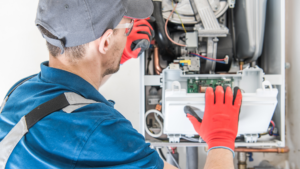
Basic Components and Operation
The majority of furnaces in the United States are powered by natural gas and contain six essential parts: a gas valve, an ignition switch, burners, an induced draft motor, a heat exchanger, and a blower fan. Their operation is controlled by your thermostat, which monitors temperatures inside your home.
As soon as they drop too low, the thermostat signals the furnace to open the gas valve. This activates the ignition switch, which ignites the burners once gas begins flowing into them. (Older systems use a pilot light instead.) Then the induced draft motor pulls the flames into the heat exchanger, warming it up. At the same time, the blower fan pulls cold air into the heat exchanger, which raises its temperature before sending it back out into your home.
Electrical furnaces are the second most common furnace in America and work along similar lines, except they use heating coils instead of burners. Once temperatures fall below your desired level, the thermostat triggers the furnace, which powers up the coils inside the heat exchanger. Then, just like in a gas furnace, the draft motor and blower fan begin drawing cold air in and pushing warm air out.
Furnace Types
Furnaces are classified according to speed ‒ how fast they move air through your home. Fan speed is one of the factors that affect its Annual Fuel Utilization Efficiency (AFUE) rating, which measures the percentage of heat produced per dollar of fuel spent. Though it seems natural that a fast furnace would be more efficient, it’s actually the opposite. Furnaces that can slow their fans are far better at heating your home.
- Single Stage. Single stage furnaces have only one speed: full blast. Because they can’t modulate their operation, they have an 80 AFUE rating, one of the lowest. Approximately 20 percent of the energy they consume is burned away and exhausted before it can be used to heat your home.
- Two Stage. Two stage furnaces have three settings instead of two: closed, open, and partially open. When the valve is closed, the furnace is shut down. When it’s open, it runs full blast. But when it’s partially open, the furnace runs at low-speed. Fully opening the valve allows the furnace to quickly heat your home to the desired temperature. Once it’s been reached, however, partially opening the valve allows it to maintain the set temperature by adding small amounts of heat. Two stage furnaces have a 90 AFUE rating.
- Variable Speed. Because they have multiple valve settings, variable speed furnaces provide greater control over your home temperature. By closely regulating output, they avoid wasteful fuel consumption, burning only enough to heat your home. Modern variable speed furnaces have AFUE ratings close to 100, the highest on the market.
Fuel Types
Besides its speed, the other major factor that determines a furnace’s AFUE rating is the type of fuel it consumes. Clean-burning fuels generate more heat and less waste, lowering both your energy costs and carbon footprint.
- Oil. Oil furnaces power their burners by drawing fuel from underground tanks and igniting it inside their heat exchangers. At one time, oil was the most popular fuel on the market. However, with the development of more efficient sources, most oil furnaces have been phased out.
- Natural Gas. Natural gas is one of the most efficient fuels available. Low-cost and clean-burning, its AFUE rating far exceeds most competitors.
- Propane. Propane contains 2,516 BTUs per cubic foot, more than any other type of fuel. It’s also more expensive than any other type of fuel, which is why it is rarely found outside of rural areas, where natural gas connections are difficult to establish.
- Electricity. Electric furnaces have the highest AFUE rating. Though they are cheap to install, they’re expensive to operate, due to the comparatively high price of electricity vs. natural gas.
Protect Your Furnace
Every furnace is subject to wear and tear. Gears, valves, circuits, and motors wear out over time. Before the need for repair arises, protect yourself by becoming an Agway customer. Our customers benefit from the included protection of EnergyGuardTM, which protects your heating, cooling, and electric lines*.
When a problem occurs, our customers don’t have to waste time searching for a qualified technician. They call us instead. We send a contractor straight to their home and pay for all covered parts. There are no service fees or deductibles either. Contact us and start saving today!
*Coverage depends on which commodity you purchase.